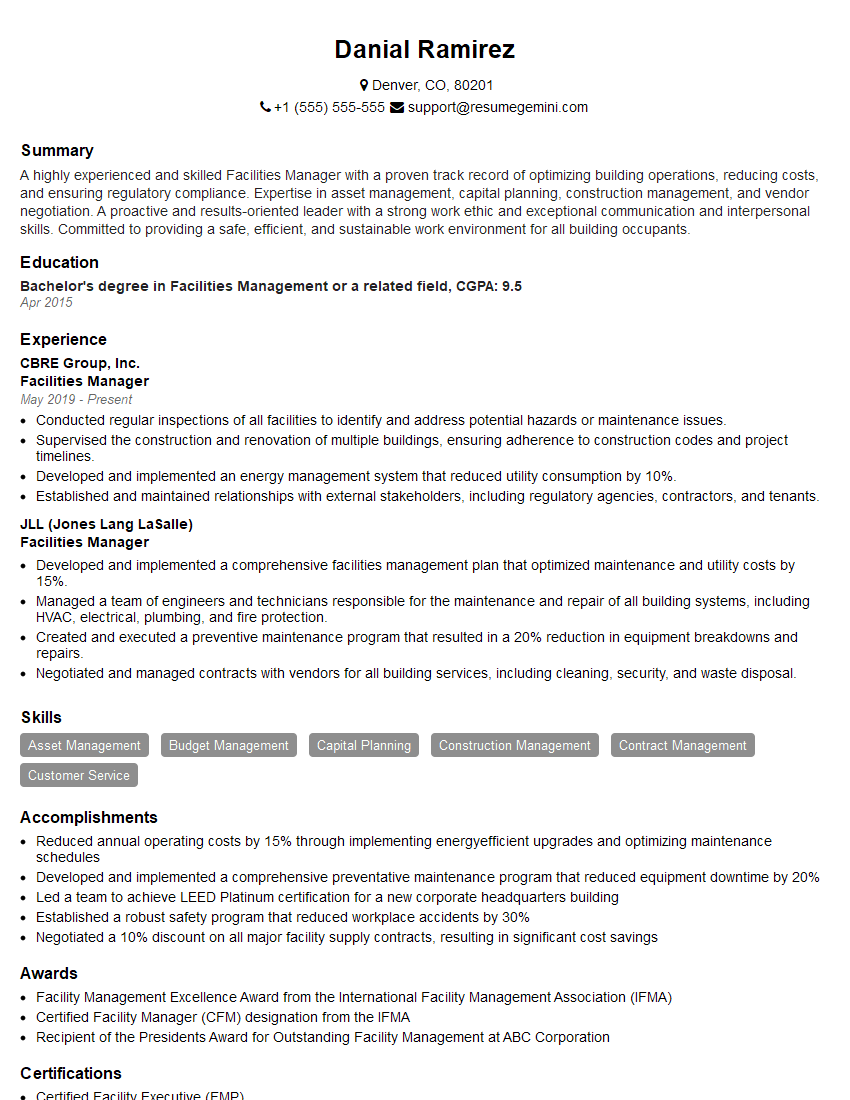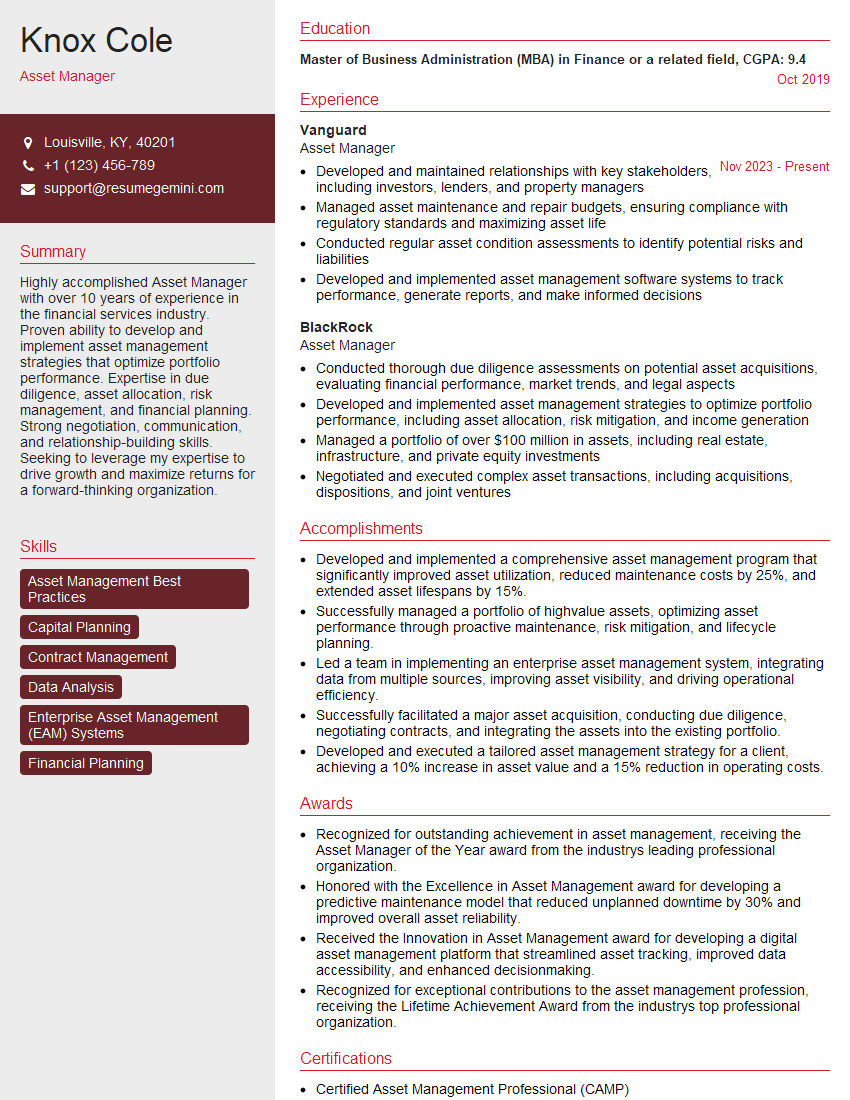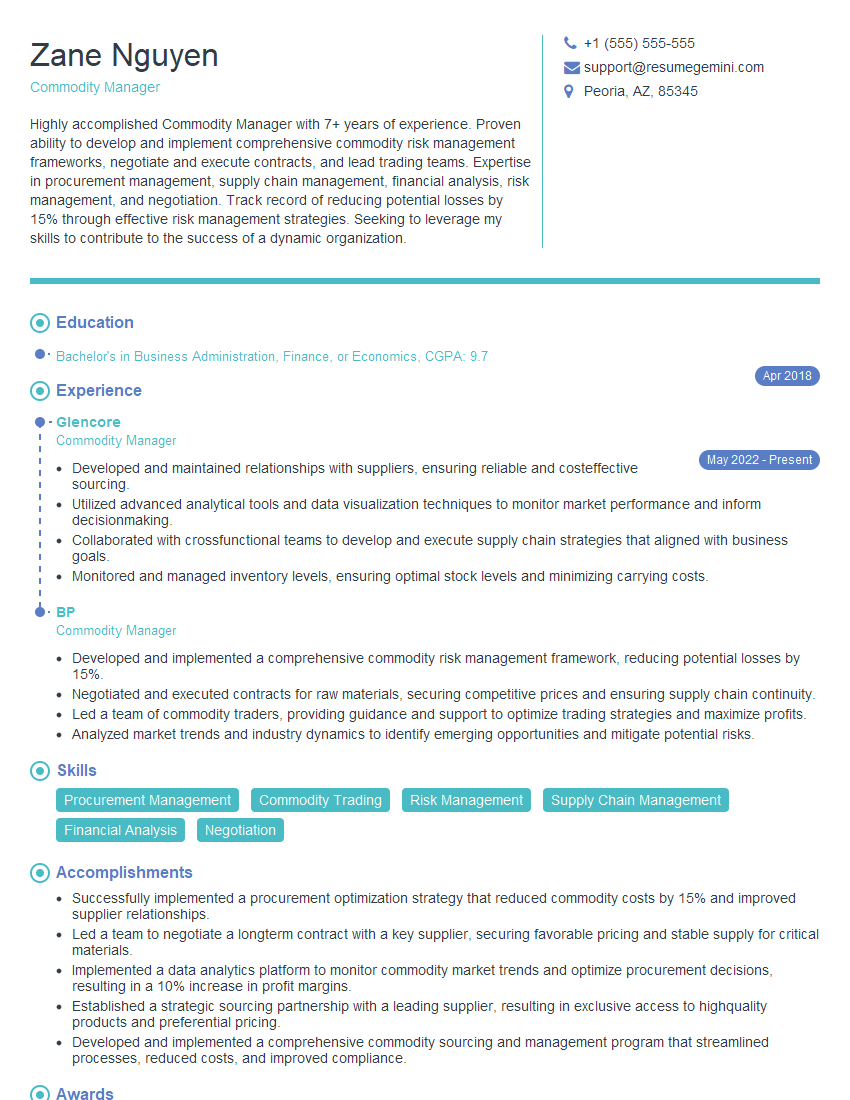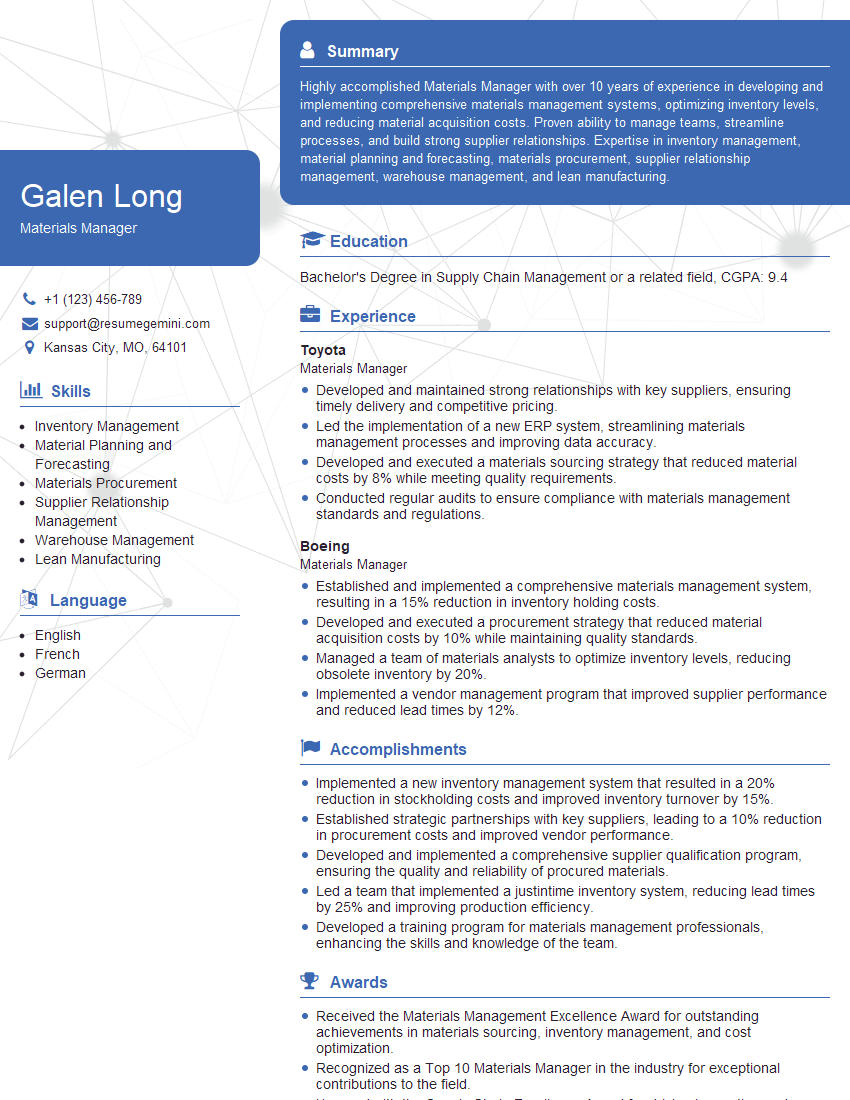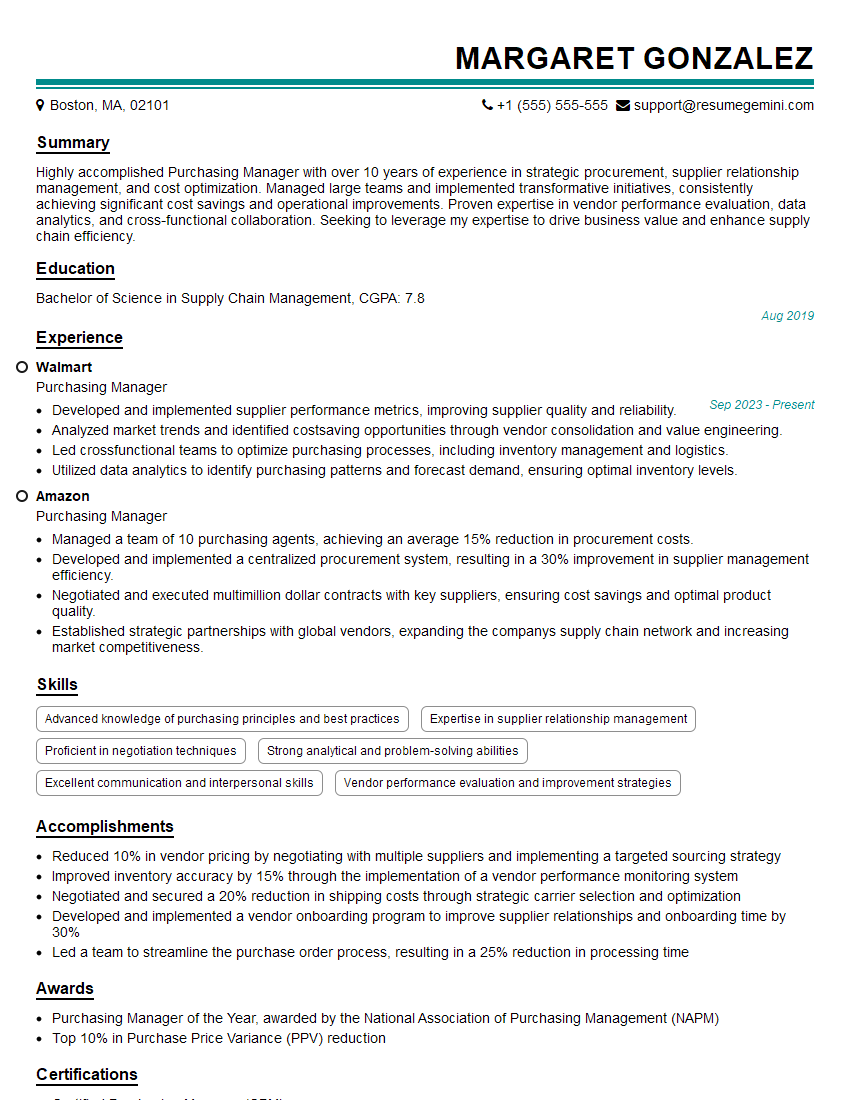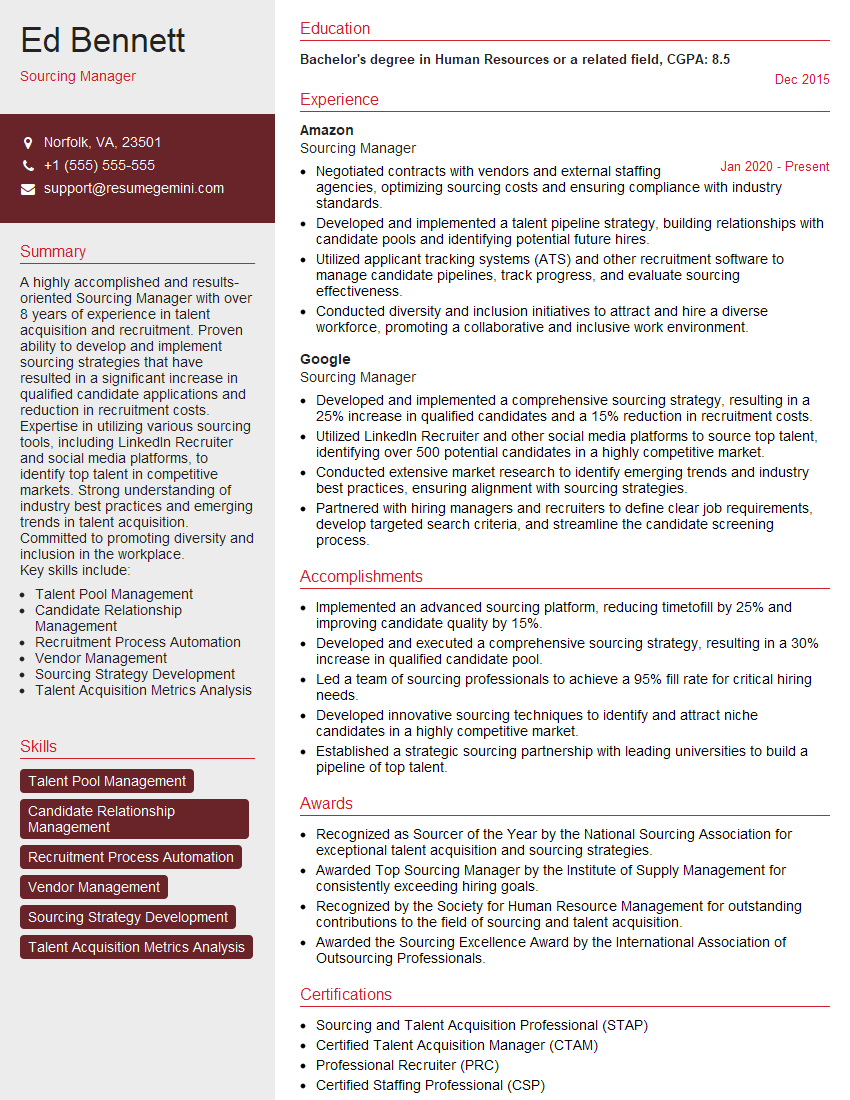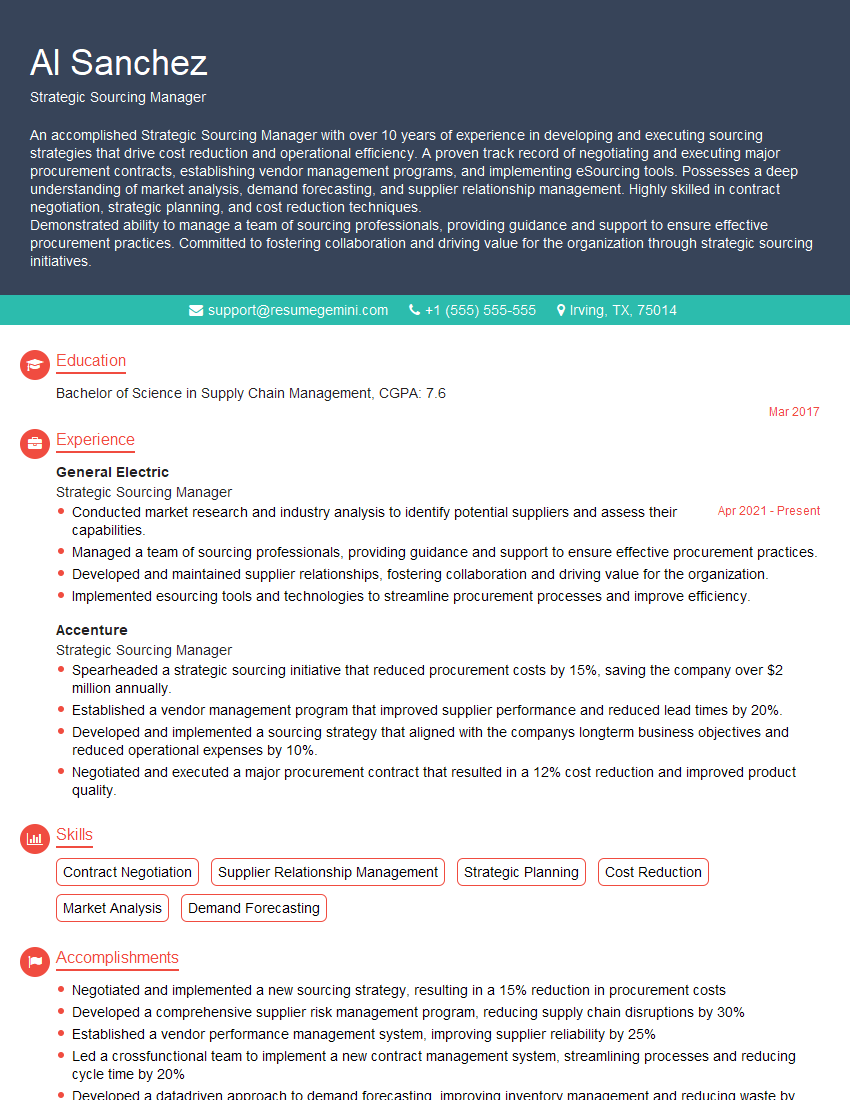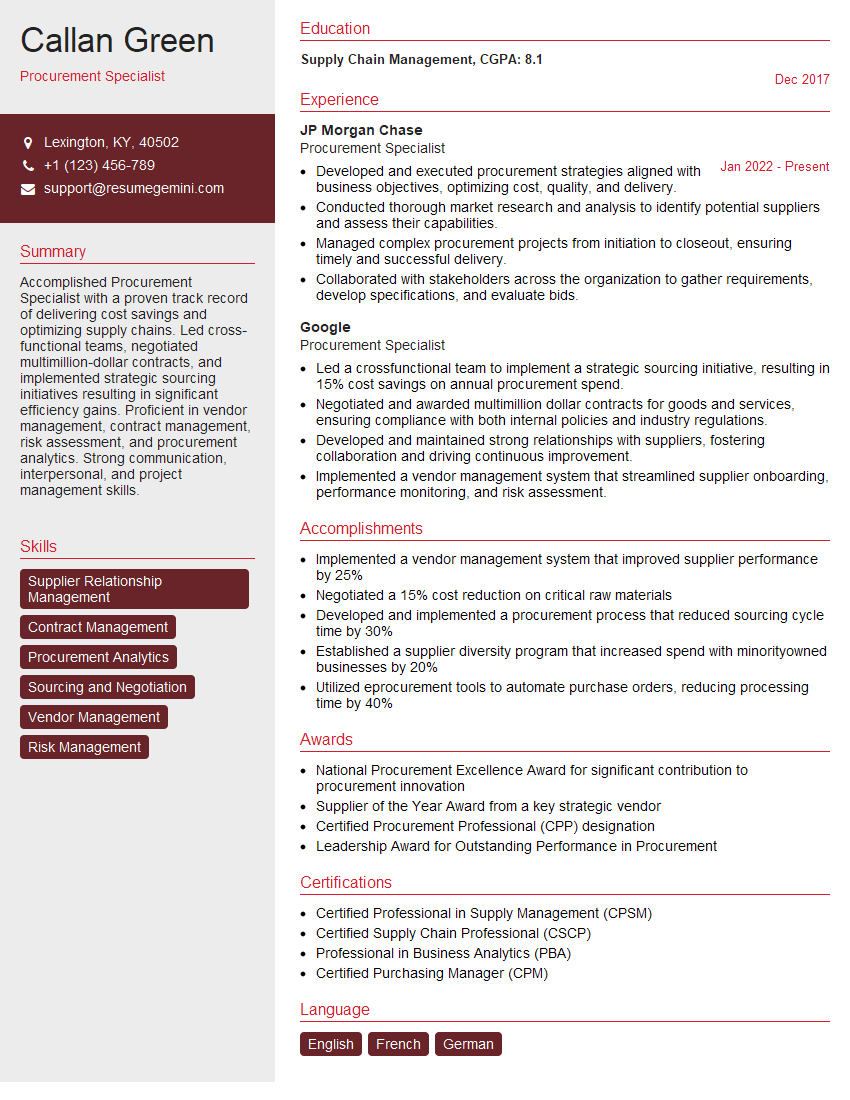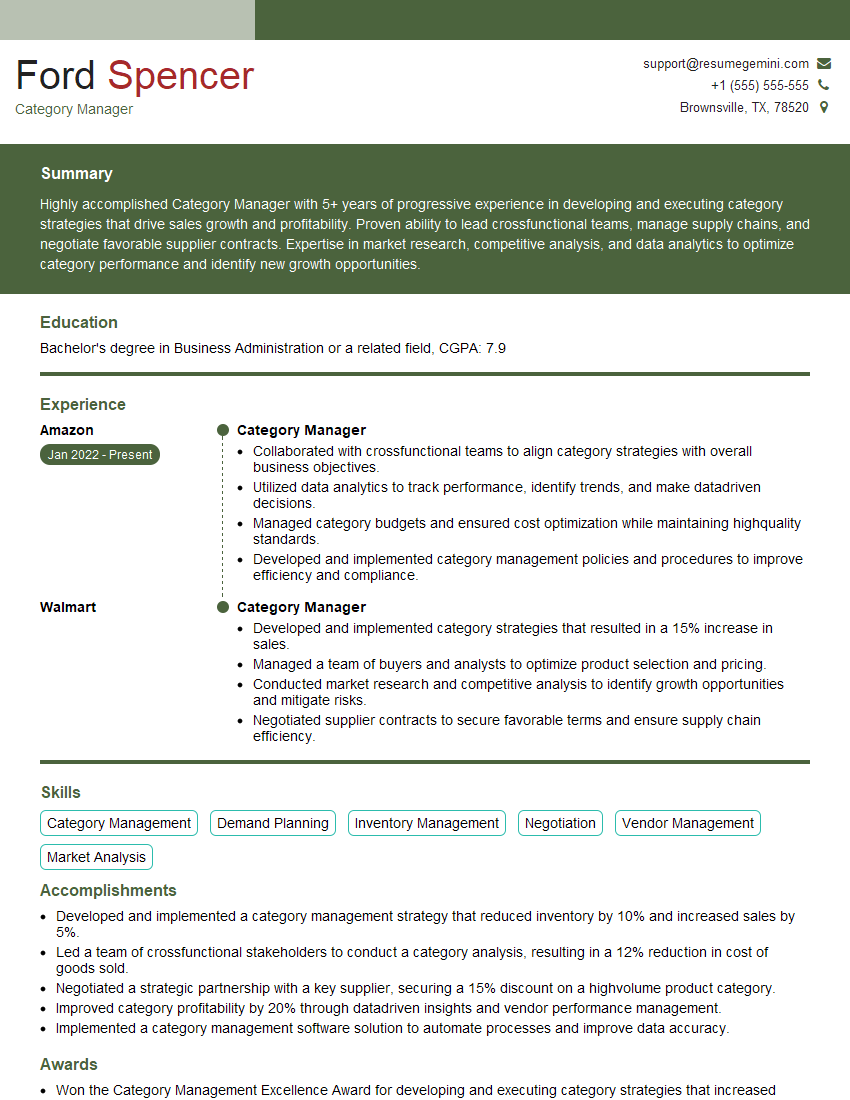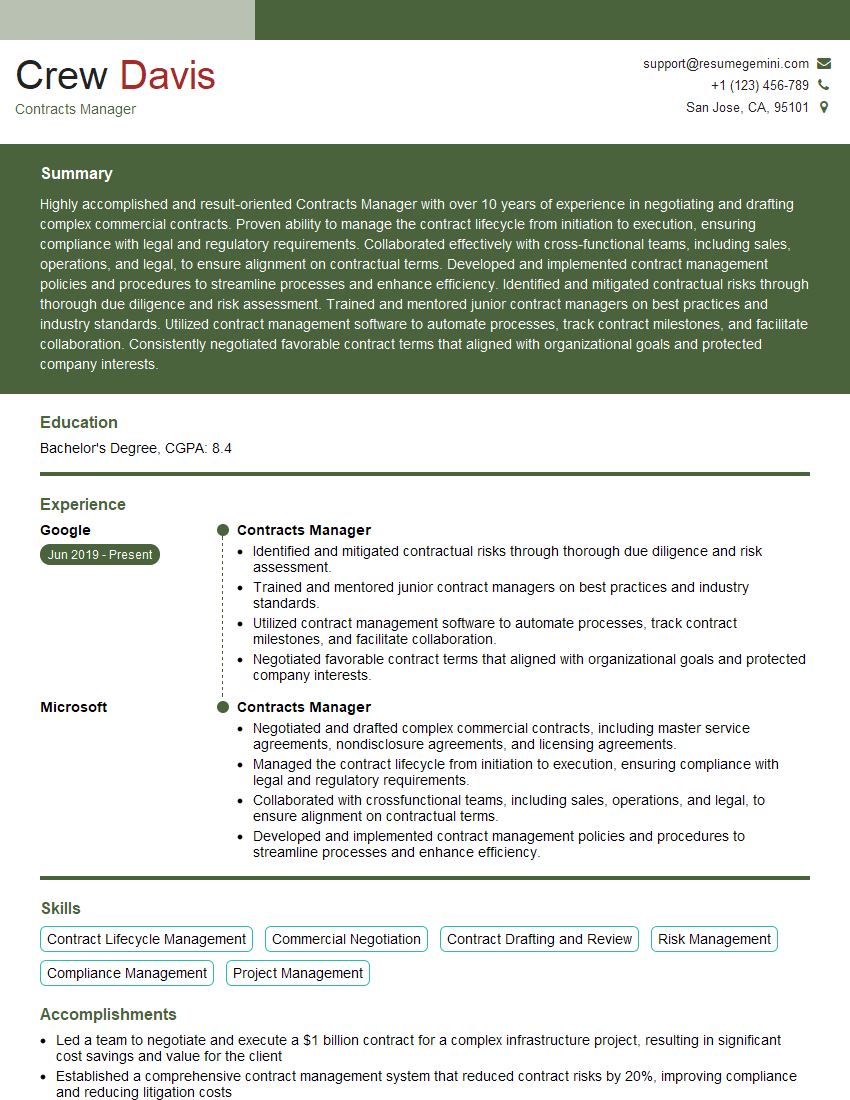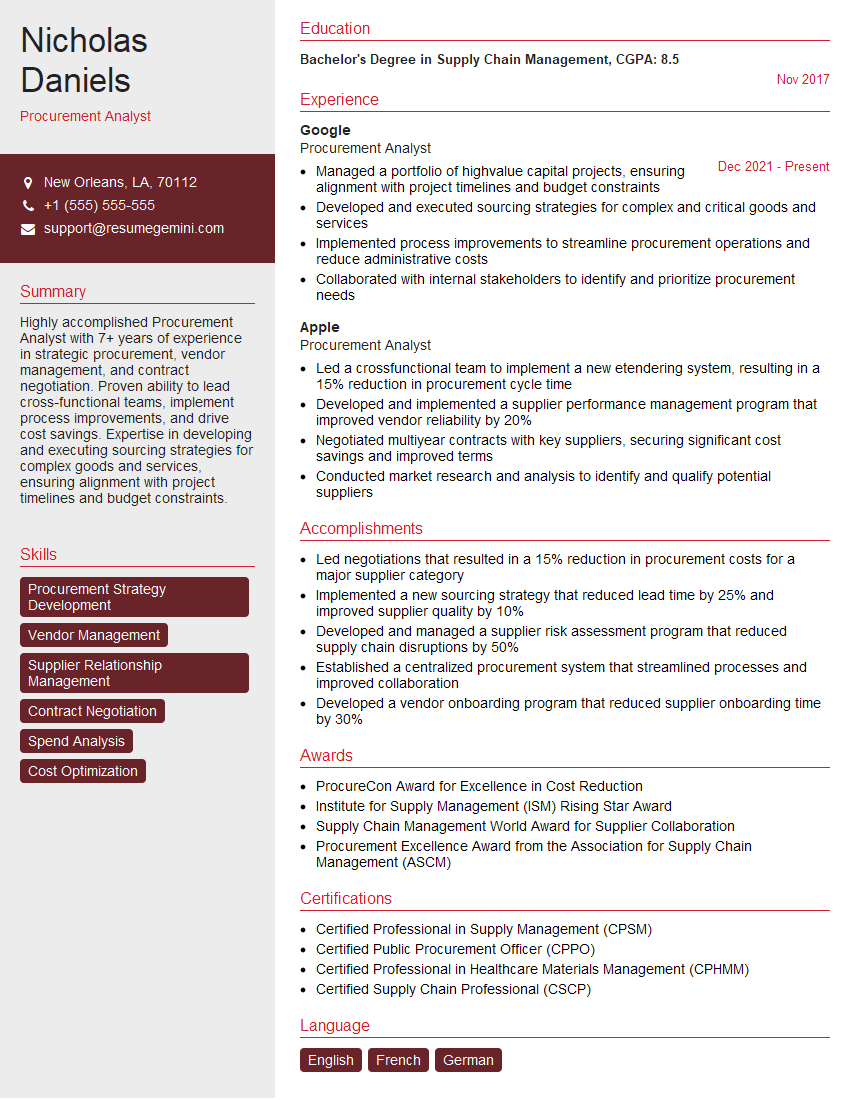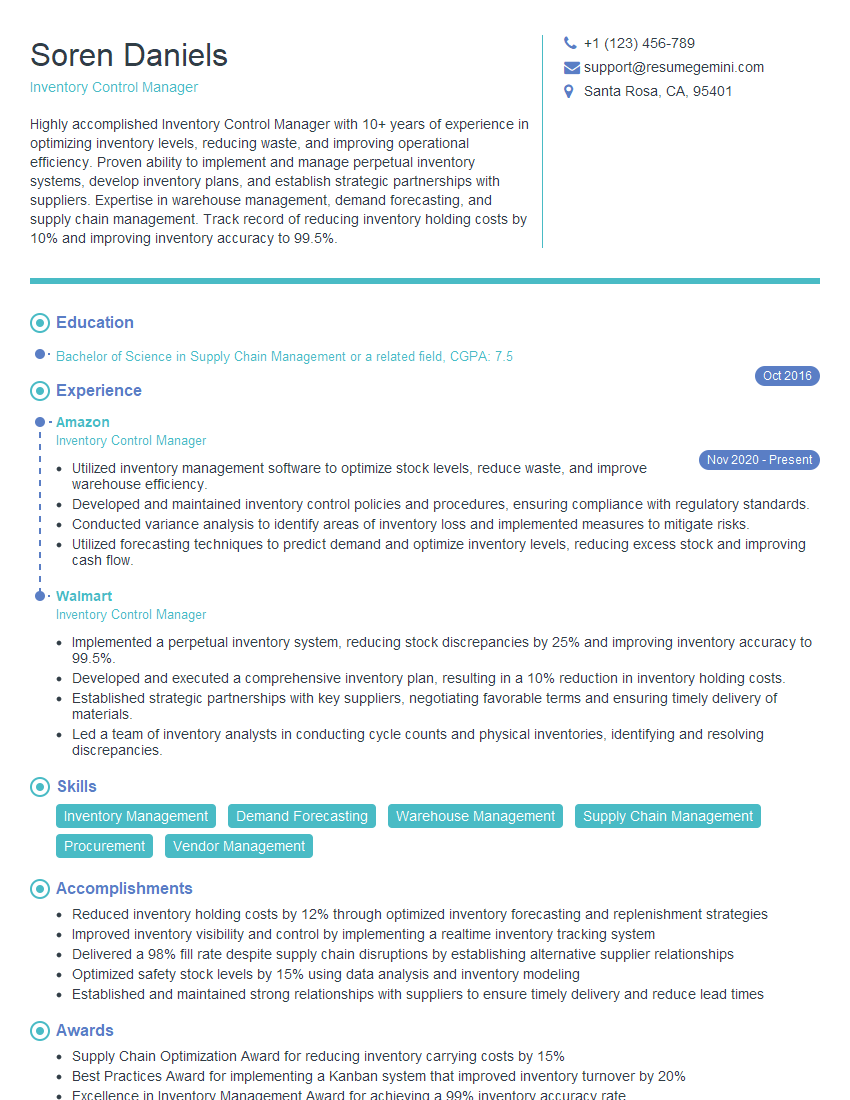Interviews are opportunities to demonstrate your expertise, and this guide is here to help you shine. Explore the essential Equipment Procurement and Management interview questions that employers frequently ask, paired with strategies for crafting responses that set you apart from the competition.
Questions Asked in Equipment Procurement and Management Interview
Q 1. Explain the process of identifying and selecting equipment vendors.
Identifying and selecting equipment vendors is a crucial step in ensuring efficient and cost-effective procurement. It’s a multi-stage process that begins with defining your needs, researching potential vendors, and ultimately choosing the best fit.
- Needs Definition: Start by clearly specifying your equipment requirements – type, capacity, features, performance metrics, and budget. For example, if you need a forklift, you’ll need to specify the lifting capacity, fuel type, and desired safety features.
- Vendor Research: Utilize online databases, industry directories, trade shows, and referrals to identify potential vendors. Consider factors like vendor reputation, financial stability, past performance, and customer reviews. Websites like Thomasnet can be invaluable resources for finding suitable vendors.
- Shortlisting & Qualification: Narrow down your list to a manageable number of vendors based on your initial research. This involves requesting detailed information about their products, services, and capabilities. Pre-qualification questionnaires can help streamline this process.
- Vendor Evaluation & Selection: Finally, thoroughly evaluate the shortlisted vendors based on criteria like price, quality, delivery time, warranty terms, and after-sales support. A weighted scoring system can provide a structured approach to comparing different vendors. For instance, you might assign higher weights to factors like reliability and long-term support than to price alone.
Think of it like choosing a car – you wouldn’t buy the first one you see; you’d compare features, price, reliability, and reviews before making a decision. Selecting equipment vendors follows the same principle, albeit with a more complex evaluation process.
Q 2. Describe your experience with Request for Proposal (RFP) development and management.
Developing and managing Request for Proposals (RFPs) is a critical aspect of my experience. A well-structured RFP ensures you receive comprehensive responses that facilitate informed decision-making. My approach involves a structured process:
- Scope Definition: Clearly defining the project scope, requirements, and deliverables is paramount. This includes technical specifications, performance expectations, timelines, and payment terms. Ambiguity at this stage leads to inconsistent bids.
- RFP Development: The RFP document itself should be detailed yet concise, outlining all requirements, submission instructions, evaluation criteria, and a clear timeline. A poorly written RFP can lead to incomplete or irrelevant proposals.
- Vendor Communication: Proactive communication with potential vendors before and after RFP distribution is crucial to ensure they understand the requirements and have the opportunity to ask clarifying questions.
- Proposal Evaluation: Once proposals are received, a thorough evaluation is essential. This often involves a scoring system based on predetermined criteria, allowing for objective comparison of different options. This ensures fairness and transparency.
- Negotiation and Award: Negotiating with the preferred vendor to refine pricing, terms, and conditions before finalizing the contract is a critical step. This involves a balanced approach – ensuring value for your organization while maintaining a positive relationship with the vendor.
In one instance, I developed an RFP for a sophisticated manufacturing system. Careful planning and clear communication resulted in proposals that were exceptionally detailed and directly addressed our specific needs, enabling us to select the optimal vendor and system.
Q 3. How do you evaluate the total cost of ownership (TCO) of equipment?
Evaluating the Total Cost of Ownership (TCO) goes beyond the initial purchase price. It encompasses all direct and indirect costs associated with acquiring, operating, and disposing of equipment over its entire lifespan.
- Initial Costs: This includes the purchase price, shipping, installation, and initial training.
- Operating Costs: Consider energy consumption, maintenance, repairs, consumables, and labor costs. For example, a high-efficiency machine may have a higher initial cost but lower long-term operating expenses.
- Maintenance Costs: Factor in planned maintenance, unplanned repairs, and replacement parts. Robust maintenance contracts can mitigate unexpected expenses but add to the overall TCO.
- Disposal Costs: Include costs associated with decommissioning, recycling, or disposal of the equipment at the end of its useful life.
We use spreadsheets and specialized software to model TCO. This allows for comparing different options and making informed decisions. For example, choosing between two machines with similar functionalities but different energy efficiencies might reveal a significant difference in long-term operating costs, leading to a more cost-effective choice.
Q 4. What methods do you use to negotiate favorable pricing and contract terms?
Negotiating favorable pricing and contract terms requires preparation, strategy, and skilled communication. I utilize a collaborative approach:
- Preparation: Thoroughly research market prices, analyze competitor offerings, and understand the vendor’s cost structure. This provides a strong foundation for negotiations.
- Strategy: Develop a clear negotiation strategy, defining your desired outcomes and acceptable alternatives. Having a clear understanding of your ‘walk-away’ point is crucial.
- Communication: Focus on building rapport and maintaining a professional, collaborative relationship with the vendor. Clearly articulate your needs and justify your position based on market data and industry best practices.
- Value-Based Negotiation: Emphasize the long-term value proposition of your organization as a client, highlighting the potential for future business and collaborative opportunities.
- Leverage: Strategically utilize alternative vendors as leverage during negotiations. This encourages competitive pricing and favorable terms.
In a recent negotiation, by showcasing our research and presenting a well-structured proposal, we managed to secure a significant discount along with an extended warranty, exceeding our initial expectations.
Q 5. How do you manage equipment maintenance and repair contracts?
Managing equipment maintenance and repair contracts is critical for ensuring equipment uptime and minimizing downtime costs. My approach involves:
- Contract Selection: Carefully evaluate different maintenance contract options, considering factors like coverage, response times, and cost. Balancing comprehensive coverage with cost-effectiveness is essential.
- Performance Monitoring: Regularly monitor the vendor’s performance against the contract terms, ensuring adherence to service level agreements (SLAs). Tracking key metrics like response times and repair durations is important.
- Relationship Management: Maintain a strong working relationship with the maintenance provider, fostering open communication and proactive problem-solving. Regular meetings and performance reviews are beneficial.
- Preventative Maintenance: Implement a robust preventative maintenance program to minimize the need for reactive repairs and extend equipment lifespan. This includes regular inspections, lubrication, and part replacements.
- Record Keeping: Maintain detailed records of all maintenance activities, repairs, and costs. This information is crucial for evaluating contract performance, planning future maintenance, and justifying expenditure.
For instance, we implemented a centralized system for tracking maintenance activities, which allowed us to identify recurring issues and negotiate more favorable contract terms with the vendor by highlighting areas for improvement.
Q 6. Describe your experience with inventory management systems and techniques.
Effective inventory management systems and techniques are essential for optimizing resource allocation and minimizing costs. My experience includes utilizing both manual and computerized systems.
- Inventory Tracking: Implementing a system for tracking equipment location, condition, and usage is crucial. This can range from simple spreadsheets to sophisticated CMMS (Computerized Maintenance Management System) software.
- Data Analysis: Analyzing inventory data to identify trends, forecast demand, and optimize stock levels is vital. This can help prevent stockouts and reduce storage costs.
- Cycle Counting: Regular cycle counting verifies the accuracy of inventory records, minimizing discrepancies and ensuring the system reflects reality. This is a crucial aspect of preventing inventory discrepancies.
- ABC Analysis: Categorizing equipment based on its value and usage (A, B, and C items) allows for focused management efforts. High-value equipment (A items) requires more rigorous tracking and control.
- Software Integration: Integrating inventory management systems with other business systems (like procurement and accounting) streamlines processes and improves data accuracy. This can often save time and improve efficiency significantly.
In a previous role, we implemented a CMMS system which dramatically improved our inventory accuracy, reduced downtime caused by missing parts, and streamlined the procurement process.
Q 7. Explain your process for tracking equipment performance and identifying areas for improvement.
Tracking equipment performance and identifying areas for improvement is a continuous process that ensures optimal efficiency and productivity. My approach involves:
- Key Performance Indicators (KPIs): Defining and monitoring relevant KPIs, such as uptime, throughput, maintenance costs, and energy consumption, provides insights into equipment performance.
- Data Collection: Implementing methods for collecting real-time data on equipment operation, including automated sensors and data logging systems. This provides a robust data set for analysis.
- Data Analysis: Analyzing collected data to identify trends, anomalies, and potential areas for improvement. Statistical process control (SPC) techniques can be invaluable for identifying patterns and predicting problems.
- Root Cause Analysis: Using techniques like the ‘5 Whys’ to investigate equipment failures and identify the root causes, preventing recurrence. Addressing the root cause is far more effective than just treating symptoms.
- Process Improvement: Implementing changes based on data-driven insights to enhance equipment performance, reduce downtime, and optimize resource allocation. Examples include modifying maintenance schedules, improving operator training, or upgrading equipment.
For example, through regular data analysis of our fleet of delivery trucks, we identified a pattern of increased fuel consumption during certain times of day. This allowed us to investigate and optimize driving routes, leading to a significant reduction in fuel costs and environmental impact.
Q 8. How do you ensure compliance with regulatory requirements related to equipment procurement?
Ensuring compliance in equipment procurement involves a multi-step process that begins even before the procurement process itself. We start by thoroughly understanding all applicable regulations, which can vary widely depending on the industry, location, and the type of equipment being purchased. This includes reviewing safety standards (e.g., OSHA regulations), environmental regulations (e.g., EPA guidelines for disposal), and any specific industry-specific requirements. We then build these requirements into our procurement specifications and contracts. This isn’t a one-time action; it’s an ongoing process of monitoring and updating as regulations evolve. For example, if we’re procuring heavy machinery, we’ll ensure compliance with relevant safety standards by requiring vendors to provide certifications and proof of adherence. Post-procurement, we maintain detailed records of all purchased equipment and its compliance certifications to facilitate audits and ensure ongoing compliance.
Furthermore, we conduct regular internal audits to verify our compliance procedures are effective and identify any areas for improvement. We also provide training to our procurement team to ensure they are up-to-date on the latest regulations and best practices. This proactive and multi-faceted approach ensures we not only meet but exceed regulatory expectations, minimizing risk and ensuring ethical and legal operations.
Q 9. Describe a time you had to resolve a critical equipment failure. What was your approach?
During a major plant overhaul, our critical cooling system failed, threatening production downtime and significant financial losses. My approach was methodical and prioritized swift resolution. First, I activated our emergency response plan, which included immediately isolating the affected area to prevent further damage and ensuring the safety of personnel. Simultaneously, a team was assembled to diagnose the problem. We leveraged the equipment’s built-in diagnostics and consulted the manufacturer’s technical documentation. We quickly identified a faulty compressor as the root cause.
Next, I initiated parallel efforts: one team focused on sourcing a replacement compressor, exploring options ranging from expedited shipping of a new part to locating a compatible used part from a reliable supplier. The other team worked on implementing temporary cooling solutions to minimize production disruption while we waited for the replacement. This involved redirecting airflow and temporarily reducing the workload of other less critical systems. Within 36 hours, we had a replacement compressor installed and the cooling system back online, minimizing downtime and preventing significant financial losses. This situation reinforced the importance of having robust emergency procedures, strong supplier relationships, and readily available contingency plans.
Q 10. How do you prioritize equipment purchases based on budget constraints and operational needs?
Prioritizing equipment purchases under budget constraints requires a strategic approach that balances operational needs with financial realities. We employ a scoring system that weighs both factors. This system typically assigns points based on factors such as:
- Criticality: How essential is the equipment to ongoing operations? A vital piece of machinery gets a higher score than a supplementary tool.
- Return on Investment (ROI): What’s the projected return in terms of increased efficiency, reduced costs, or new revenue opportunities?
- Urgency: Is there an immediate need for the equipment, or can the purchase be deferred?
- Cost: The equipment’s price is factored into the score, balancing need against budget limitations.
The items with the highest scores are prioritized. This helps us make data-driven decisions that maximize value within the allocated budget. For example, if we have a limited budget but a critical piece of equipment is failing, that would receive top priority, even if other items would provide a higher long-term ROI.
Q 11. Explain your understanding of different purchasing methods (e.g., competitive bidding, reverse auctions).
Different purchasing methods cater to various needs and circumstances. Understanding their strengths and weaknesses is crucial. Let’s examine a few:
- Competitive Bidding: This involves inviting multiple vendors to submit sealed bids for a specific requirement. It’s transparent and fosters competition, typically resulting in lower prices. It’s best suited for well-defined requirements and standardized goods or services.
- Reverse Auctions: This is a dynamic process where vendors compete by progressively lowering their prices until a winner is selected. It’s effective for driving down costs but requires careful monitoring and can sometimes compromise quality if solely focused on price.
- Negotiated Procurement: This is often used for complex or specialized equipment where a detailed specification might not be feasible upfront. It requires strong negotiation skills and a thorough understanding of market pricing.
- Direct Purchase: For small-value or readily available items, a direct purchase from a trusted supplier can be the most efficient method.
The choice of method depends on the specific situation. Factors like the complexity of the item, the number of potential suppliers, budget constraints, and time constraints all play a crucial role in determining the best approach.
Q 12. How do you manage risk associated with equipment procurement and supply chain disruptions?
Managing risk in equipment procurement and mitigating supply chain disruptions involves proactive measures throughout the entire process. We start by diversifying our supplier base to avoid over-reliance on a single vendor. This reduces vulnerability to disruptions at a single source. We also build strong relationships with key suppliers, fostering open communication and collaboration. This helps us anticipate potential issues early on.
We utilize robust contract management, including clearly defined service level agreements (SLAs) and penalty clauses for non-compliance. This ensures suppliers meet their obligations and holds them accountable. We also conduct thorough due diligence on potential suppliers, assessing their financial stability, production capacity, and track record. Finally, we maintain a comprehensive inventory management system that tracks equipment usage, maintenance schedules, and replacement parts. This allows us to anticipate maintenance needs and proactively manage potential failures. In addition, we develop contingency plans to address potential supply chain disruptions, identifying alternative suppliers or exploring alternative materials or solutions.
Q 13. What metrics do you use to evaluate the success of your procurement efforts?
Evaluating the success of our procurement efforts relies on a set of key performance indicators (KPIs). These metrics help us track efficiency, cost-effectiveness, and overall impact. Here are some examples:
- Total Cost of Ownership (TCO): This considers not only the initial purchase price but also maintenance, repair, and disposal costs over the equipment’s lifespan.
- Procurement Cycle Time: How long does it take to complete the procurement process from initial requisition to final delivery?
- Supplier Performance: We track metrics like on-time delivery, quality of goods, and responsiveness to issues.
- Budget Adherence: Did we stay within the allocated budget for each procurement?
- Equipment Uptime: This metric, often expressed as a percentage, reflects the percentage of time the equipment is operational. High uptime indicates effective procurement and maintenance.
By regularly monitoring these KPIs, we can identify areas for improvement and fine-tune our procurement strategies to optimize efficiency and cost-effectiveness.
Q 14. Describe your experience with using procurement software and tools.
My experience with procurement software and tools is extensive. I’ve worked with various systems, from enterprise resource planning (ERP) systems like SAP and Oracle to specialized procurement platforms. These tools have significantly streamlined our processes, improving efficiency and transparency. Specifically, I’ve utilized systems to manage the entire procurement lifecycle, from requisitioning and bidding to contract management and invoice processing.
These systems offer features such as automated workflows, real-time tracking of orders, and comprehensive reporting capabilities. For example, using a procurement platform with integrated e-procurement functionalities helps expedite the procurement process, reduces paperwork, and enhances collaboration with vendors. The ability to track KPIs within the software allows for data-driven decision making and continuous improvement. Furthermore, these systems often include built-in compliance features, helping us to ensure adherence to regulations.
Q 15. How do you ensure the ethical and responsible sourcing of equipment?
Ensuring ethical and responsible sourcing of equipment is paramount. It involves prioritizing suppliers who adhere to high ethical and environmental standards. This goes beyond simply finding the cheapest option; it’s about considering the entire supply chain.
- Due Diligence: We thoroughly vet potential suppliers, investigating their labor practices, environmental impact, and compliance with relevant laws and regulations. This might include reviewing their certifications (e.g., ISO 14001 for environmental management) and conducting site visits.
- Fair Labor Practices: We actively seek suppliers committed to fair wages, safe working conditions, and no child labor. We may use third-party audits to verify these claims.
- Environmental Sustainability: We favor suppliers who prioritize resource efficiency, waste reduction, and the use of sustainable materials. This could involve looking for products with recycled content or reduced carbon footprints.
- Transparency and Traceability: We demand transparency throughout the supply chain, enabling us to track the origin of materials and ensure compliance with our ethical standards. This helps mitigate risks associated with conflict minerals or other ethically problematic materials.
For example, in a recent project, we chose a supplier who used recycled aluminum for their equipment housings, despite a slightly higher initial cost, because their commitment to sustainability aligned with our company values and reduced our overall environmental impact.
Career Expert Tips:
- Ace those interviews! Prepare effectively by reviewing the Top 50 Most Common Interview Questions on ResumeGemini.
- Navigate your job search with confidence! Explore a wide range of Career Tips on ResumeGemini. Learn about common challenges and recommendations to overcome them.
- Craft the perfect resume! Master the Art of Resume Writing with ResumeGemini’s guide. Showcase your unique qualifications and achievements effectively.
- Don’t miss out on holiday savings! Build your dream resume with ResumeGemini’s ATS optimized templates.
Q 16. What is your experience with lease vs. buy decisions for equipment?
Lease vs. buy decisions require a careful cost-benefit analysis. The optimal choice depends heavily on factors like the equipment’s lifespan, usage intensity, technological obsolescence rate, and the company’s financial position.
- Leasing: Leasing is advantageous when the equipment is likely to become obsolete quickly, requires minimal upfront capital investment, or when regular upgrades are anticipated. The predictable monthly payments improve budget forecasting.
- Buying: Buying is preferable when the equipment has a long lifespan, usage is high, and the long-term cost of ownership (including maintenance and repairs) is lower than lease payments. Ownership also grants greater control and potential for resale value.
In one instance, we opted to lease high-tech analytical equipment with a short expected lifespan and rapid technological advancement. This allowed us to access the latest technology without large upfront capital outlay. Conversely, for essential manufacturing equipment with a projected 10+ year lifespan, we chose to buy, as the long-term cost savings outweighed the initial investment.
Q 17. How do you manage the disposal or decommissioning of obsolete equipment?
Managing the disposal or decommissioning of obsolete equipment necessitates a structured approach that prioritizes safety, environmental responsibility, and regulatory compliance.
- Asset Inventory: We maintain a detailed inventory of all equipment, including its age, condition, and potential resale value.
- Data Security: Before disposal, we ensure all sensitive data is securely erased from any hardware or software.
- Environmental Compliance: We adhere to all local, state, and federal regulations regarding the disposal of hazardous materials or e-waste. This often involves using certified recycling or disposal vendors.
- Resale or Donation: We explore options to resell or donate still-functional equipment to charities or educational institutions.
- Recycling and Responsible Disposal: For equipment that cannot be reused, we utilize certified e-waste recycling facilities to minimize environmental impact.
For example, we recently decommissioned a server rack. We securely wiped the hard drives, then partnered with a certified e-waste recycler to dismantle and recycle the remaining components responsibly, ensuring compliance with environmental protection regulations.
Q 18. Describe your experience with international procurement and logistics.
My experience with international procurement and logistics is extensive. It involves navigating complexities including international trade regulations, customs procedures, currency fluctuations, and diverse logistical challenges.
- International Trade Regulations: We understand and comply with import/export regulations, tariffs, and trade agreements (e.g., NAFTA, WTO). This includes proper documentation (e.g., commercial invoices, packing lists).
- Logistics Management: We manage the entire shipping process, from selecting suitable freight forwarders and customs brokers to tracking shipments and handling potential delays.
- Incoterms: We effectively utilize Incoterms (International Commercial Terms) to clearly define responsibilities and liabilities between buyers and sellers across international borders.
- Currency Exchange and Risk Management: We employ strategies to mitigate risks associated with currency fluctuations, including hedging techniques.
One project involved sourcing specialized equipment from a manufacturer in Germany. We successfully navigated the complexities of EU export regulations, international shipping, and customs clearance, delivering the equipment on time and within budget. Effective communication with international partners was crucial to this success.
Q 19. How do you build and maintain strong relationships with suppliers?
Building and maintaining strong relationships with suppliers is vital for efficient and reliable procurement. It’s a long-term investment that pays dividends in terms of cost savings, quality assurance, and timely delivery.
- Regular Communication: We maintain open and consistent communication, establishing clear channels for feedback and issue resolution.
- Performance Evaluation: We regularly evaluate supplier performance based on key metrics such as on-time delivery, quality, and responsiveness.
- Collaboration and Partnership: We view suppliers as partners, working collaboratively to identify cost savings, improve quality, and solve problems proactively.
- Fair and Transparent Practices: We engage in fair and transparent business practices, ensuring timely payments and clear contract terms.
For example, our relationship with one key supplier has evolved over several years into a strategic partnership. This has resulted in preferential pricing, priority access to new technologies, and a consistently high level of service and support.
Q 20. How do you handle discrepancies between purchase orders and invoices?
Discrepancies between purchase orders (POs) and invoices require immediate attention and a systematic approach to resolution.
- Verification and Reconciliation: We meticulously compare the PO and invoice, item by item, noting any discrepancies in quantity, price, or description.
- Communication with Supplier: We promptly contact the supplier, providing documented evidence of the discrepancy and requesting clarification or correction.
- Internal Investigation: We investigate internally to identify the root cause of the discrepancy, whether it stems from a PO error, an invoice error, or a data entry problem.
- Documentation: We meticulously document all communication and resolution steps, ensuring a clear audit trail.
In a recent case, we identified a pricing discrepancy on an invoice. By referencing the original PO and supplier contract, we successfully negotiated a price adjustment, avoiding unnecessary payment of an inflated amount.
Q 21. Explain your experience with contract lifecycle management.
Contract lifecycle management (CLM) is crucial for optimizing procurement processes. It involves a structured approach to managing contracts from creation to renewal or termination.
- Contract Creation and Negotiation: We use standardized templates and rigorous review processes to ensure contracts are clear, comprehensive, and legally sound. This includes risk mitigation clauses.
- Contract Execution and Monitoring: We establish a system for monitoring contract compliance, performance, and key milestones.
- Contract Renewal and Amendment: We manage contract renewals, amendments, and extensions efficiently, ensuring compliance and value for our organization.
- Contract Repository: We maintain a centralized repository for all contracts, ensuring easy access and retrieval for authorized personnel.
- Automated Tools: We leverage CLM software to automate tasks such as contract creation, routing, approvals, and performance monitoring.
By implementing a robust CLM system, we reduced contract-related risks, improved compliance, and streamlined our procurement processes, leading to significant time and cost savings. We also improved visibility into our contractual obligations and performance against those obligations.
Q 22. Describe your process for conducting vendor performance reviews.
Vendor performance reviews are crucial for maintaining high standards and optimizing procurement outcomes. My process is multifaceted and data-driven. It begins with establishing clear Key Performance Indicators (KPIs) before the contract is even signed. These KPIs might include on-time delivery rates, adherence to specifications, responsiveness to requests, and cost-effectiveness.
Next, I implement a structured review process. This typically involves regular meetings, usually quarterly, where I gather data from various sources: purchase orders, delivery receipts, invoice processing times, quality control reports and, crucially, feedback from internal stakeholders who use the equipment. This holistic approach ensures I get a complete picture.
During these reviews, we discuss performance against KPIs, identify areas for improvement, and collaboratively develop action plans. For example, if a vendor consistently misses delivery deadlines, we might explore whether their production capacity needs adjustment or if improved communication is necessary. Documentation is key; we maintain a detailed record of all reviews, including agreed-upon actions and timelines for implementation. Finally, the review process informs future vendor selection and contract negotiations, ensuring we partner with the best and most reliable suppliers.
A real-world example: In a previous role, a vendor consistently experienced delays in supplying critical components. Through our review process, we discovered their internal logistical systems needed improvement. By working collaboratively, we implemented a solution to streamline their processes leading to a significant improvement in on-time delivery, resulting in less project downtime and improved overall efficiency.
Q 23. How do you implement and enforce procurement policies and procedures?
Implementing and enforcing procurement policies and procedures requires a multi-pronged approach focusing on clarity, communication, and accountability. It begins with creating a comprehensive policy document that’s easily accessible and understandable by all stakeholders, encompassing areas such as vendor selection criteria, contract negotiation guidelines, ethical sourcing practices, and approval workflows.
To ensure effectiveness, training is paramount. All involved personnel, from procurement officers to project managers, need comprehensive training on the policies and procedures. Regular refresher training keeps everyone updated on changes and best practices.
Next, I establish clear roles and responsibilities. Who approves what? Who’s responsible for which stage of the procurement cycle? This prevents ambiguity and ensures proper oversight. We also integrate the policies into our procurement systems, using technology to automate certain steps and flag potential deviations. This could include using a procurement software with built-in checks and balances. For example, the system might automatically reject purchase orders exceeding pre-defined budget limits.
Accountability is crucial; any deviation from the policy should be meticulously documented and investigated. Regular audits assess policy compliance and identify areas for improvement. Consequences for non-compliance, clearly defined in the policy, act as a deterrent. Think of it like a well-oiled machine; each part plays a role, and deviations from the process are addressed swiftly and efficiently.
Q 24. How familiar are you with different types of equipment financing options?
My familiarity with equipment financing options is extensive, spanning various approaches tailored to different needs and risk profiles. These include:
- Operating Leases: These are short-term rentals where the lessor retains ownership of the equipment. They’re ideal for short-term projects or when trying new technology without committing to long-term ownership. The monthly payments are typically lower than other options.
- Capital Leases (Finance Leases): These are longer-term agreements where the lessee assumes most of the risks and benefits of ownership. While they have higher initial payments, they often offer lower overall costs compared to operating leases if the equipment is used for a longer duration.
- Hire Purchase Agreements: Similar to capital leases, but usually involve a final purchase option at a predetermined price. This is useful when the company eventually wants to own the equipment.
- Bank Loans: Direct financing from a bank, requiring a comprehensive credit assessment. This provides greater ownership flexibility but demands strong financial standing.
- Vendor Financing: Financing offered directly by the equipment supplier, often with attractive terms, but might limit choices.
The choice depends on factors such as budget, the equipment’s lifespan, and the company’s financial position. I carefully evaluate each option, conducting thorough due diligence to find the most cost-effective and suitable financing method for each procurement scenario.
Q 25. Describe your experience with developing and managing equipment budgets.
Developing and managing equipment budgets requires a detailed understanding of anticipated needs, cost estimations, and financial constraints. It starts with forecasting: projecting future equipment requirements based on business plans and operational needs. This involves identifying necessary upgrades, replacements, or new acquisitions. For example, if expansion is anticipated, we might need to factor in the cost of additional machinery or vehicles.
Next, I create a detailed budget, categorized by equipment type, anticipated costs (including purchase price, shipping, installation, and maintenance), and funding sources. This process often involves working closely with finance and operations teams to align budgetary needs with overall financial plans. We utilize tools like spreadsheets and budgeting software to track expenditures and monitor variances. Regular reviews of the budget are critical to ensure it stays on track and any deviations are addressed proactively.
Contingency planning is crucial. Unforeseen circumstances like equipment malfunctions or price increases can significantly impact the budget. Therefore, a percentage is often allocated as a buffer for unexpected costs. In my experience, strong communication with stakeholders, regular reporting, and data-driven decision-making are essential for effective equipment budget management.
Q 26. How do you ensure the timely delivery of equipment?
Ensuring timely equipment delivery is a critical aspect of efficient procurement. My approach involves proactive measures throughout the procurement cycle, starting with clear contract specifications and timelines. These contracts must stipulate precise delivery dates, penalties for late delivery, and clear acceptance criteria.
I actively monitor the delivery process using a combination of techniques. This includes regularly checking in with the vendor regarding production progress and logistics, using project management software to track key milestones and potential delays, and establishing a formal communication channel for reporting issues promptly.
Furthermore, I build in buffer time to accommodate unforeseen delays. This is especially important for complex equipment requiring long lead times. In the event of a delay, I immediately initiate corrective actions, including communicating the situation to stakeholders, negotiating revised delivery dates with the vendor, and exploring alternative solutions if necessary, such as expedited shipping or sourcing from a different supplier if the delay is critical.
For example, in a previous project involving specialized machinery, we anticipated a possible delay due to global supply chain disruptions. We proactively communicated this to the stakeholders, allowing them to adjust their project plans accordingly. We also identified a backup supplier to reduce risks and successfully avoided significant project delays.
Q 27. What is your experience with using data analytics to improve procurement processes?
Data analytics plays a pivotal role in optimizing procurement processes. I leverage data analytics to identify trends, improve efficiency, and reduce costs. This involves collecting data from various sources, such as purchase orders, invoices, vendor performance metrics, and equipment maintenance records.
These data points are analyzed using various techniques, including descriptive statistics, predictive modeling, and machine learning. For instance, analyzing historical procurement data helps identify patterns in pricing fluctuations. This knowledge informs better negotiation strategies and more accurate budget forecasting. Predictive analytics might help identify potential supply chain disruptions, enabling proactive mitigation efforts.
I use data visualization tools to present findings to stakeholders. Dashboards are crucial for monitoring key performance indicators (KPIs) and tracking progress toward improvement goals. These visualizations make complex data easy to understand and foster informed decision-making. For example, a dashboard showing the on-time delivery rates of different vendors immediately highlights which suppliers are exceeding expectations and which might require attention.
Furthermore, data-driven insights help optimize inventory management, reducing storage costs and minimizing risks associated with obsolete equipment. In essence, data-driven decision-making is fundamental to cost savings and efficiency gains throughout the procurement lifecycle.
Q 28. How do you handle equipment returns or warranty claims?
Handling equipment returns or warranty claims requires a systematic and documented approach to protect the organization’s interests while ensuring fairness and compliance with contractual agreements. This process starts with a clear understanding of the return or warranty terms as outlined in the contract with the vendor. All claims must be properly documented, including dates, descriptions of defects, and any supporting evidence such as photos or videos.
Next, I initiate the return or warranty process by contacting the vendor, providing all the necessary documentation, and coordinating the return of the equipment or the necessary repairs. This includes clearly defining the expected resolution (repair, replacement, or refund). Throughout the process, I maintain meticulous records of communications, agreements, and any costs incurred.
For example, if a piece of equipment malfunctions within the warranty period, I’ll contact the vendor immediately, provide evidence of the malfunction, and request repair or replacement as per the terms of the contract. If the vendor fails to respond promptly or adequately address the issue, we have established escalation procedures, potentially involving legal counsel if necessary. Transparency and prompt communication with internal stakeholders are essential throughout the process, keeping them informed of the status and progress of the claim. Ultimately, our goal is to secure a timely and fair resolution that minimizes disruption and protects our investment.
Key Topics to Learn for Equipment Procurement and Management Interview
- Needs Assessment and Planning: Defining equipment requirements based on operational needs, budget constraints, and future projections. Practical application: Developing a comprehensive RFP (Request for Proposal) based on a thorough needs analysis.
- Sourcing and Procurement Strategies: Exploring various procurement methods (e.g., competitive bidding, negotiation, leasing), understanding supplier selection criteria, and managing supplier relationships. Practical application: Negotiating favorable contract terms and conditions with vendors.
- Budget Management and Cost Control: Developing and managing equipment budgets, tracking expenditures, and implementing cost-saving measures. Practical application: Utilizing cost-benefit analysis to justify equipment purchases.
- Contract Negotiation and Management: Understanding contract law, negotiating favorable terms, managing contract performance, and resolving disputes. Practical application: Drafting and reviewing equipment purchase agreements.
- Equipment Lifecycle Management: Planning for acquisition, operation, maintenance, and disposal of equipment, including considerations for asset tracking and depreciation. Practical application: Implementing a preventative maintenance program to extend equipment lifespan.
- Risk Management and Mitigation: Identifying and mitigating potential risks associated with equipment procurement and management, such as supply chain disruptions, equipment failures, and safety hazards. Practical application: Developing a risk assessment plan and implementing appropriate mitigation strategies.
- Technology and Software Applications: Familiarity with relevant software and technologies used for equipment management, such as CMMS (Computerized Maintenance Management Systems) and ERP (Enterprise Resource Planning) systems. Practical application: Utilizing CMMS software to track maintenance schedules and equipment performance.
- Compliance and Regulations: Understanding relevant industry regulations and compliance requirements related to equipment safety, environmental protection, and ethical sourcing. Practical application: Ensuring compliance with all relevant safety and environmental regulations.
Next Steps
Mastering Equipment Procurement and Management opens doors to rewarding and challenging career opportunities with significant growth potential. A strong understanding of these principles is highly valued across various industries. To maximize your job prospects, focus on crafting an ATS-friendly resume that effectively showcases your skills and experience. ResumeGemini is a trusted resource to help you build a professional resume that stands out. Utilize their tools and resources, and take advantage of the examples of resumes tailored to Equipment Procurement and Management available to help you create a compelling application.
Explore more articles
Users Rating of Our Blogs
Share Your Experience
We value your feedback! Please rate our content and share your thoughts (optional).
What Readers Say About Our Blog
This was kind of a unique content I found around the specialized skills. Very helpful questions and good detailed answers.
Very Helpful blog, thank you Interviewgemini team.
